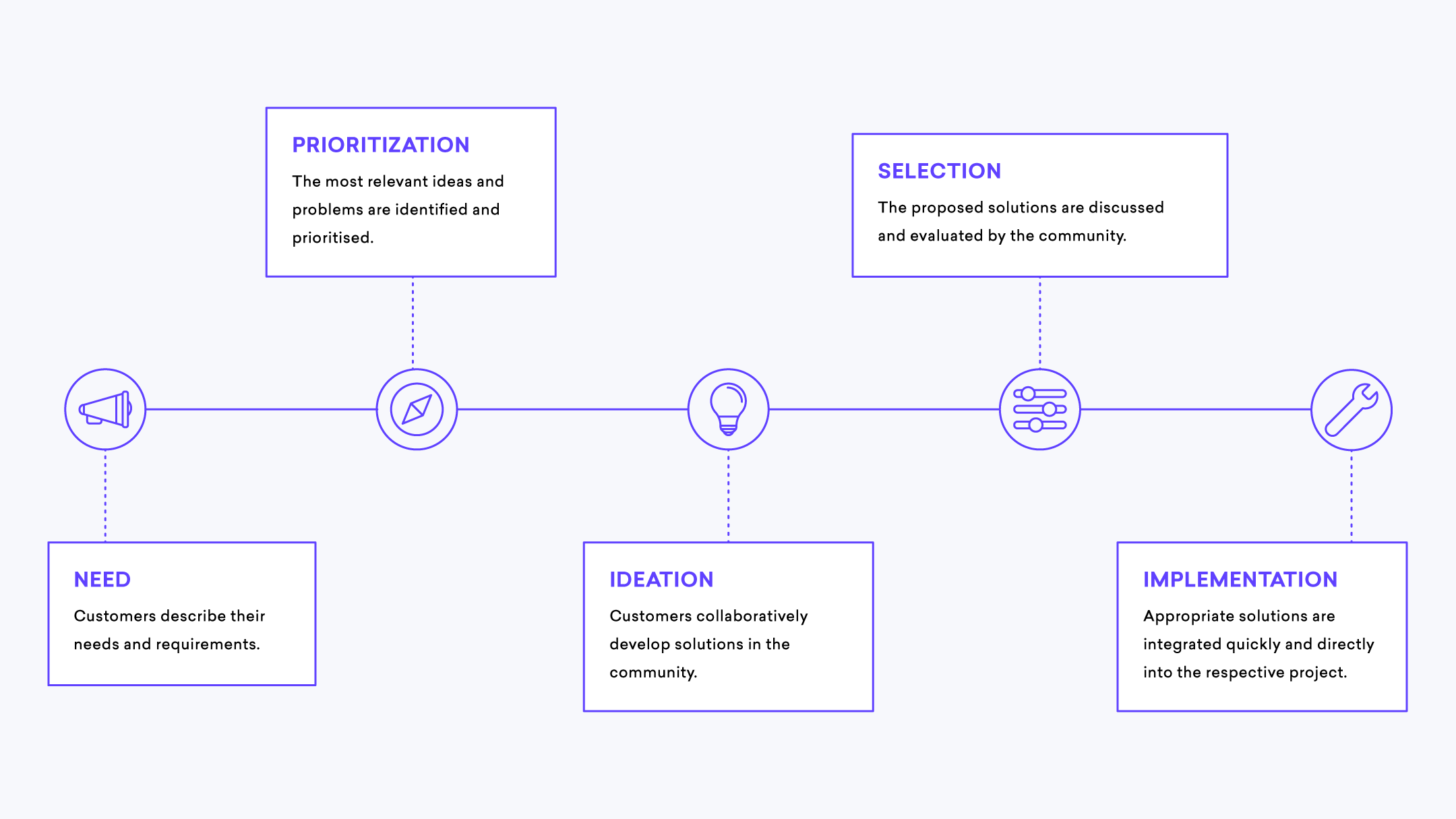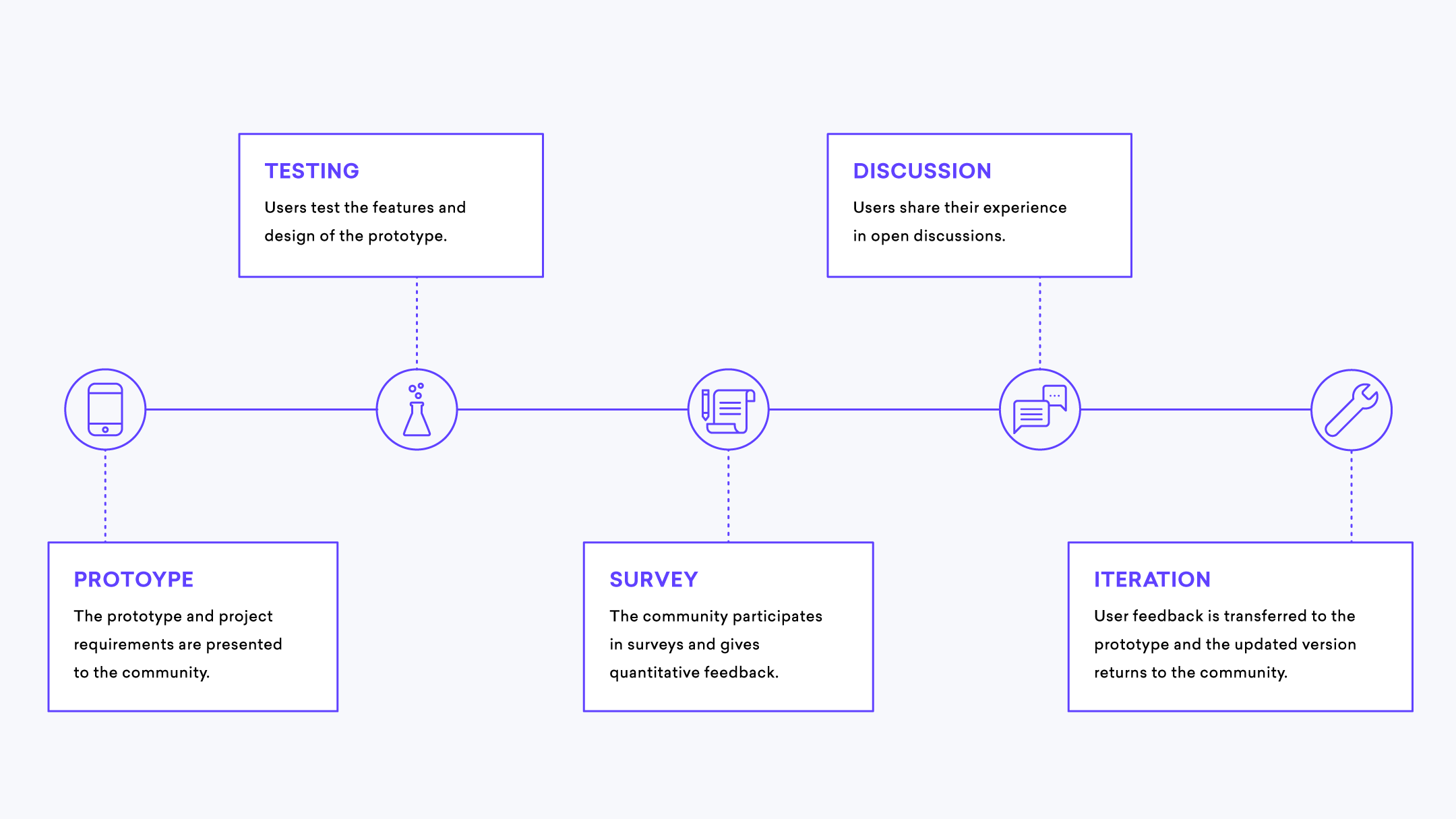Co-Creation With Customers
01 Executive Summary: Key Facts at a Glance
Innovations are successful if they provide solutions for existing challenges or problems of the target group. The own customers are a central source of knowledge to identify needs and deficits and derive solutions.
- Large-scale co-creation projects enable companies to integrate their customers into the innovation process and establish real proximity using direct exchange channels, which positively affects customer relations.
- Open Innovation Platforms open new ways for customer-centric, agile product development. They combine the qualitative advantages of design thinking and lead user approaches with the quantitative benefits.
- Through collaboration with many users, needs can be identified, appropriate solutions developed, and then immediately tested.
- With their iterative loops, digital prototypes ensure a customer-oriented implementation of products and services while at the same time reducing the use of resources.
- The Supercharger provides access to two million consumers worldwide at the touch of a button, even without setting up your community.
- Openness and transparency towards external stakeholders form the basis of an innovation culture, along with the willingness to fail and learn from mistakes.
02 Why Involve Customers?
The obvious answer to this question is that nobody influences the success of a product or service more than the customer. The possibilities offered by new technologies to fulfill wishes in real-time have changed expectations and created a demand for more individuality. By integrating customers and their wishes into the innovation process, the success probability of the products and the customer’s loyalty to the brand can be increased. Consumers have the opportunity to contribute throughout the entire process – from brainstorming to product development to testing prototypes. Like this, the relevant user requirements can be identified, but their feedback can be incorporated into the implementation early and continuously. This increases customer satisfaction while reducing uncertainties, costs, and time.
Sounds promising? Well, yes, it is. Platform solutions create unlimited space for interaction. Customer insights can be seamlessly integrated into the innovation process using them wisely.
03 Creating Real Customer Proximity With Co-creation and Customer Centricity
Customer Centricity means that all processes, decisions, and company activities meet customer needs. Methods such as design thinking or the lead user approach make it possible to approach the requirements and wishes of users on a personal and qualitative level. The interaction of heterogeneous knowledge sources and the possibility of direct exchange create a more open approach to collecting and exploiting ideas. These are now generated, discussed, and further developed with the community. Thus, the perspectives of all stakeholders are taken into account, and a solution supported by all participants is created.
- Design Thinking as the basis for an agile, customer-centric approach
- Real customer proximity through direct exchange
- Fast identification of customer needs
- Unlimited collaboration possibilities with the customer
The advantages of the methods described above can be realized with a platform solution in a very short time and scaled for the application of large user groups. They create real customer proximity through various collaboration possibilities, which is more than just direct exchange. Customers can use the platform to share their ideas, discuss them with others, develop them further, have them tested for feasibility or even translate them into finished products together with the company. Customer orientation becomes customer integration.
04 New Ways of Product Development
Digitalization means competing with companies in the same industry and being able to react to new, intersectoral products in the shortest possible time. For successful product development, it is therefore important to deal continuously with the needs of the target group and always adapt to new requirements. The origin of new product ideas is no longer the research and development departments of large companies but primarily the customers themselves. By combining customer proximity with agile methods in innovation processes, the necessary adaptability and speed can be achieved in product development. In this way, tailor-made solutions can be offered to consumers as quickly as possible.
- Customer-centric, agile product development
- Identifying needs, developing solutions, testing results
- Agile Product Development: Speed potential through openness and flexibility
Open Innovation Platforms enable companies to quickly and easily integrate many customers into open collaboration projects. Various interaction possibilities make it possible to exchange new ideas with the customer and design innovative products collaboratively. The products and services are no longer presented when mature but are put to a market test within individual development stages earliest possible. This leads to optimized resources and maximum flexibility within the single adjustment steps.
05 Crowd Innovation: Developing Products With Customers
Innovation can neither be planned nor ordered, but there are conditions that support it. Fresh ideas arise when you create space and time for creative processes. Openness is the key to thought-provoking impulses and developments in every direction. And above all, it needs the exchange with others to receive new impulses. So, if a company faces the challenge of adapting existing products, improving them, or creating completely new ones, it has various options. Either it relies on a few experts with the appropriate knowledge – which can lead to success. Still, there is the danger that an already successful procedure will be copied or that the ideas will pass the actual needs of the target group by self-confirmation loops and opinion makers within the expert group.

Or the company establishes an open innovation platform for structured collaboration projects directly with the target group. People with different perspectives, professional backgrounds, and knowledge meet, exchange ideas, and set new impulses—perfect conditions for the emergence of something new and creative. Especially with user-centered products and services, it is essential to involve the customer in the entire innovation process. Needs are identified together, and appropriate solutions are developed, tested, and implemented in flexible adaptation loops.
06 Digital Prototypes: Testing Products With Customers
The invention of something new requires the courage to make mistakes. If companies decide to regard mistakes as a source of improvement and to be open to external criticism, they can use feedback to their advantage. However, the principle of openness must be lived consistently: The organization must not only be open to the customers’ suggestions for improvement but also decide against keeping the latest product developments secret. In contrast to secrecy, openness enables access to more knowledge, ideas, and perspectives:

With digital testing of prototypes, companies have the opportunity to test unfinished products or services with a large number of users. This reduces development time and costs. Investments in wrong ideas are thus avoided, and the wishes of potential buyers are taken into account at an early stage. Testing prototypes together with customers allows companies to perform iterative feedback loops. Using beta versions, click dummies and mock-ups, usability and design can be tested, and different variants can be compared with each other. Digital Prototype Testing thus enables fast and direct customer feedback, which leads to a user-centered realization of the products and ultimately to a reduction in time, costs, and risk.
07 Supercharger: Reach Millions of Consumers at the Touch of a Button
The Supercharger serves as an interface to existing communities. It provides access to over two million people worldwide at the touch of a button – without the challenge of having to set up your community first. Thus, the Supercharger is not only suitable for answering specific challenges but also for investigating open questions. With the Supercharger, assumptions concerning customer needs can be checked for correctness and acceptance within a few minutes. With the help of the Supercharger, trends can be queried, or first insights on particular topics can be gathered within a few minutes. This allows organizations to be proactive rather than reactive in dealing with customer needs and better assess future developments.
Since the Supercharger not only appeals to customers but also to consumers in general, a representative cross-section of society, as well as specific groups of people, can be surveyed according to demographic criteria. The interviewees themselves decide which questions they want to address. By this self-selection after own interests, the Supercharger ensures the participants’ motivation.
08 Best Practice: How Our Customers Are Successful
In a digital, rapidly changing world, it is crucial to identify relevant customer needs, offer appropriate solutions and be faster than the competition. It is about entering into an open dialogue with customers and exposing your products or services to customer feedback at an early stage of development. It is about direct collaboration with the users and understanding one’s customers. Our best practices for collaboration with customer communities show how successful this can be. Postbank AG and Deutsche Bank AG – companies that have successfully mastered the financial sector’s digital transformation – use the innosabi software to enter into a continuous exchange with their customers and thus collaboratively identify their needs. With this platform, Telekom AG actively encourages its customers to participate in developing new products and services.
09 Identifying and Using Innovative Ideas
Ideas are the basis for inventions and innovation. Combining the most diverse fields of knowledge, perspectives and expertise increase the probability of encountering innovative ideas. In conclusion, however, this does not mean that the exchange of many people inevitably leads to good ideas. Digital platforms offer the opportunity to network knowledge so that innovative ideas can be identified and harnessed. The difficulty lies in finding useful information and relevant patterns from the flood of unstructured data.
- The customer projects are subdivided into several successive phases
- The knowledge of the crowd can be further concretized through funnel logic
- Interaction with ideas and proposed solutions serve as an indicator of relevance
- Identification of innovative ideas and strongly involved people
- Joint development and testing of solutions
By applying the logic of design thinking, large projects with customers can be broken down into smaller, successive questions. Results can be viewed, discussed, and adapted step by step before the question is concretized once more. The crucial information or persons can then be identified via the activities that arise from the dynamics of collaboration. How many users interact with an idea? How do they comment and argue? Are there people with special expert knowledge?
After identifying innovative ideas and relevant people, the next step is to jointly develop solutions and then iteratively test them. Above all, cooperation with strongly involved people should be encouraged, as they act on their initiative and want to change or redesign things.
10 The Right Software for Co-creation With Customers
Appropriate digital infrastructure is needed for actual customer proximity and integration, where customers can contribute to the entire innovation process. This infrastructure enables the company to create a customer community that can continuously be integrated. In addition, it must be characterized by openness, speed, and flexibility so that the company can quickly and constantly adapt to changing customer needs. The platform offers the freedom for requirements and needs to be thoroughly discussed and evaluated without crucial ideas being lost in the flood of data. For example, pairwise voting could be one way of structuring ideas and identifying preferences by comparing them.
The following criteria should be considered when choosing a software solution:
- Building customer communities and integrating external communities for comprehensive real-time consumer knowledge
- Collaboration opportunities in ideation, solution development, and practical implementation
- Identification of relevant ideas through the analysis of collaboration activities
- Quantitative and qualitative customer feedback on ideas, further developments, and practical implementation
- Semantic analysis of the ideas and comparison with similar contents in the database
- Gamification elements for more customer involvement